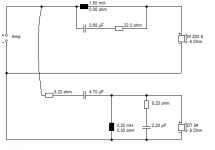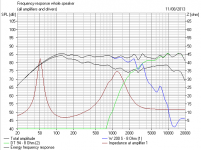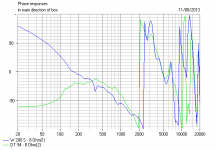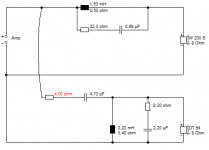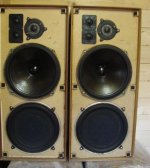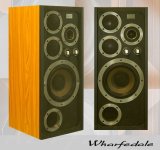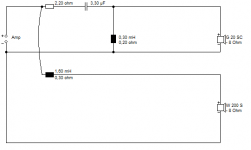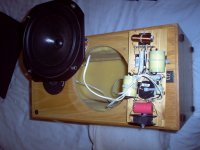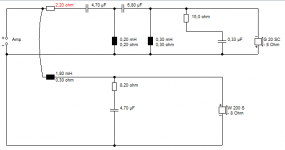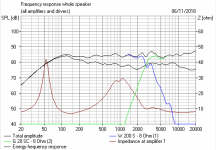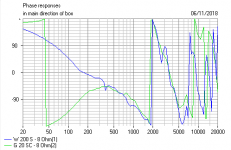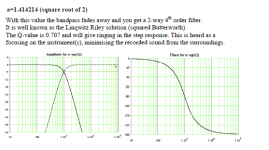Would you care to elaborate on the kind of modelling you're referring to? I may be interested in constructively disagreeing with you 🙂acoustic modeling is painfully lacking 😀
Would you care to elaborate on the kind of modelling you're referring to? I may be interested in constructively disagreeing with you 🙂
I havent a clue.. to be honest. That was a little joke of mine because he caused me minor annoyance, by posting that comment for my 3 way seas project i am working on, (exept he said einstein not da vinci)😱
Well, a little update on progress with the slightly dire Monitor Audio R300/MD speakers. 🙂
I was pretty limited by lack of precise knowledge of the drivers here, but decided to go with a better second order crossover over the original poor first order bass. Before:
After:
The crossover design:
And how it looked:
Polish it all up with some Shiny Silicone Grease on the rubber parts:
What I did in effect was reduce the coil from 1.6mH to 0.76mH to tame the bass a bit, and use really good polypropylene capacitors. It sounds very nice and is now a genuine bookshelf speaker. Imaging is good. Bass and drums is easy to follow, faultless really. The metal tweeters still sound, well METALLIC. They just don't have classical piano sounding right. I must fit soft domes soon. But a HUGE improvement. 🙂
I was pretty limited by lack of precise knowledge of the drivers here, but decided to go with a better second order crossover over the original poor first order bass. Before:
An externally hosted image should be here but it was not working when we last tested it.
After:
An externally hosted image should be here but it was not working when we last tested it.
The crossover design:
An externally hosted image should be here but it was not working when we last tested it.
And how it looked:
An externally hosted image should be here but it was not working when we last tested it.
Polish it all up with some Shiny Silicone Grease on the rubber parts:
An externally hosted image should be here but it was not working when we last tested it.
What I did in effect was reduce the coil from 1.6mH to 0.76mH to tame the bass a bit, and use really good polypropylene capacitors. It sounds very nice and is now a genuine bookshelf speaker. Imaging is good. Bass and drums is easy to follow, faultless really. The metal tweeters still sound, well METALLIC. They just don't have classical piano sounding right. I must fit soft domes soon. But a HUGE improvement. 🙂
I know this goes back to your first post, & perhaps a topic for another thread, but re: the 'the dried-up ferrofluid gunge' - so does ferrofluid have a 'shelf life', & if so, what are the contributing factors...???
The metal tweeters still sound, well METALLIC. They just don't have classical piano sounding right.
I can't help but noticing the slight peaking at 3k, 5k, and slight dip at 7k...all the woofer's fault.
if you want to add new ferrofluid back to the tweeters, here's an option:
Ferrofluid 100uL General Purpose for 1" Diameter V.C. 340-540
Ferrofluid 100uL General Purpose for 1" Diameter V.C. 340-540
This ferrofluid replacement is a more complicated issue than I thought. Apparently it comes in various grades of viscosity and iron oxide strength. Being essentially oil, a binding agent and oxide particles, I'd guess some serious hot party use will dry it up and fling it off quite quickly...😀
But at heart, I just don't like metal tweeters. They aren't neutral sounding IMO. It looks to me like the slot in replacement SEAS 19TFF1 fabric dome is going to suit me better:
Seas Prestige 19TFF1 H0737
I'm overall VERY pleased with how they are sounding now. I reckon I should refit the Zobel and reduce the tweeter capacitor back to 3.3uF to tame the slightly overdone guitar twanginess I can hear in 2-4kHz with Dire Straits, and all will be well with new fabric domes which will suit classical music and Alfred Brendel's piano better.
The bass and percussion and vocal performance is quite outstanding using them as genuine bookshelves without stands. There is no point at which they sound strained or peaky or boomy. AllenB will be aware I have a small BBC bookshelf monitor design in mind, quite retro really with classic 5:8:13 dimensions, and all this makes me think it is going to be doable. 🙂
But at heart, I just don't like metal tweeters. They aren't neutral sounding IMO. It looks to me like the slot in replacement SEAS 19TFF1 fabric dome is going to suit me better:
Seas Prestige 19TFF1 H0737
I'm overall VERY pleased with how they are sounding now. I reckon I should refit the Zobel and reduce the tweeter capacitor back to 3.3uF to tame the slightly overdone guitar twanginess I can hear in 2-4kHz with Dire Straits, and all will be well with new fabric domes which will suit classical music and Alfred Brendel's piano better.
An externally hosted image should be here but it was not working when we last tested it.
The bass and percussion and vocal performance is quite outstanding using them as genuine bookshelves without stands. There is no point at which they sound strained or peaky or boomy. AllenB will be aware I have a small BBC bookshelf monitor design in mind, quite retro really with classic 5:8:13 dimensions, and all this makes me think it is going to be doable. 🙂
I can't help but noticing the slight peaking at 3k, 5k, and slight dip at 7k...all the woofer's fault.
This was a tough decision, Allen. I could have fitted bigger 15uF to the bass and rolled it off faster, but that left me with an unwelcome and ugly peak at 1.5kHz which would have made the top strings of guitar jar IMO. 10uF also worked much better with time alignment (which is where you wire the tweeter out of phase and move it back a few centimetres, or just turn the speakers upside down), and I wanted to leave that option open for experiment later.
Progress on these 8" bass plus 1" tweeter closed box speakers:
Built a new crossover and fitted a Visaton DT 94-8 Mylar dome tweeter.
This is first order bass plus tank/notch at 5kHz. Second order tweeter. I am getting the hang of doing 8" bass with simple filter. 😎
All works very well, and the tone is very neutral and untiring. Classical piano sounds RIGHT too, not metallic. FWIW, reusing the original tweeter 3.3uF and 0.27mH components will give very similar sound I reckon.
The Visaton G20SC soft dome which is also an easy 94mm chassis to fit didn't model so well on phase.
An externally hosted image should be here but it was not working when we last tested it.
Built a new crossover and fitted a Visaton DT 94-8 Mylar dome tweeter.
An externally hosted image should be here but it was not working when we last tested it.
This is first order bass plus tank/notch at 5kHz. Second order tweeter. I am getting the hang of doing 8" bass with simple filter. 😎
An externally hosted image should be here but it was not working when we last tested it.
All works very well, and the tone is very neutral and untiring. Classical piano sounds RIGHT too, not metallic. FWIW, reusing the original tweeter 3.3uF and 0.27mH components will give very similar sound I reckon.
The Visaton G20SC soft dome which is also an easy 94mm chassis to fit didn't model so well on phase.
Attachments
I've been doing a little tweaking of the final result here. I found the Visaton DT94 mylar tweeter lacked a bit of energy, so reduced the input resistance to the HF filter from 8.2 to 4 ohms. I was a bit surprised I needed to do this, since the DT94 was about 6dB louder than the original SEAS 19TAF/G unit by my reckoning. But actually, Visaton say it is 90dB unit, so I suppose it makes sense. The Monitor Audio bass is evidently quite efficient. 😱
Nothing like actually doing it, as we used to say. 🙂
I'd also estimate that the original tweeter could have been slot-in replaced with a SEAS 19TFF soft dome, another 19TAF/G metal dome or a Morel CAT298/94 soft dome if you want to do it the easy way.
Morel Classic CAT298-94
The 22R/0.68uF tank on the bass coil was great success IMO. This is a very good speaker now with good phase alignment. system7 signing off from Monitor Audio land. Thankyou Robin Marshall for the ride. 😎
An externally hosted image should be here but it was not working when we last tested it.
Nothing like actually doing it, as we used to say. 🙂
I'd also estimate that the original tweeter could have been slot-in replaced with a SEAS 19TFF soft dome, another 19TAF/G metal dome or a Morel CAT298/94 soft dome if you want to do it the easy way.
Morel Classic CAT298-94
The 22R/0.68uF tank on the bass coil was great success IMO. This is a very good speaker now with good phase alignment. system7 signing off from Monitor Audio land. Thankyou Robin Marshall for the ride. 😎
Attachments
... so reduced the input resistance to the HF filter from 8.2 to 4 ohms. I was a bit surprised I needed to do this
We're getting rather old
😀😛😱
The Beast is back, boys and girls! 😀
It's amazing that this project has taken me so long to sort out. The big breakthrough was getting some fresh ferrofluid from Blue Aran, near Southampton. https://www.bluearan.co.uk/index.php?category=Speaker_Components&masthead=High_Frequency_Drivers&subheadnew=Ferrofluid
Nice people who mostly do PA stuff. I called in at their industrial unit by Train. Because I always like to see the operation. Enough there for 5 tweeters for £5. I just mostly filled the magnet gap and relied on the voicecoil filling the rest of the space when replaced.
I was winging it a bit on tweeter level and am guessing how the 8" woofer behaves, but so far, so good. Nicely balanced. Nothing shouts. A nice closed box design. Bit of a hybrid of BW3 and LR4. And why not? 😎
It's amazing that this project has taken me so long to sort out. The big breakthrough was getting some fresh ferrofluid from Blue Aran, near Southampton. https://www.bluearan.co.uk/index.php?category=Speaker_Components&masthead=High_Frequency_Drivers&subheadnew=Ferrofluid
Nice people who mostly do PA stuff. I called in at their industrial unit by Train. Because I always like to see the operation. Enough there for 5 tweeters for £5. I just mostly filled the magnet gap and relied on the voicecoil filling the rest of the space when replaced.
I was winging it a bit on tweeter level and am guessing how the 8" woofer behaves, but so far, so good. Nicely balanced. Nothing shouts. A nice closed box design. Bit of a hybrid of BW3 and LR4. And why not? 😎
Attachments
-
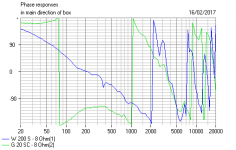 Monitor Audio R300-MD Phase.PNG21.2 KB · Views: 2,300
Monitor Audio R300-MD Phase.PNG21.2 KB · Views: 2,300 -
 Monitor Audio R300-MD FR.PNG18.5 KB · Views: 9,368
Monitor Audio R300-MD FR.PNG18.5 KB · Views: 9,368 -
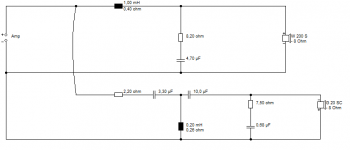 Monitor Audio R300-MD BW3 filter.PNG7.6 KB · Views: 12,680
Monitor Audio R300-MD BW3 filter.PNG7.6 KB · Views: 12,680 -
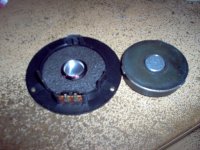 SEAS 19 TAF-G.jpg86.9 KB · Views: 16,622
SEAS 19 TAF-G.jpg86.9 KB · Views: 16,622 -
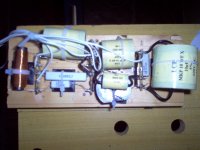 Monitor Audio R300-MD resurrected crossover.jpg236 KB · Views: 10,563
Monitor Audio R300-MD resurrected crossover.jpg236 KB · Views: 10,563 -
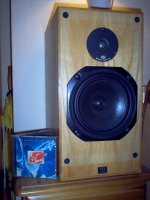 Monitor Audio R300-MD resurrected Cabinet.jpg278.1 KB · Views: 24,558
Monitor Audio R300-MD resurrected Cabinet.jpg278.1 KB · Views: 24,558
TBH, erik, I was quite pleased to finish with this one.
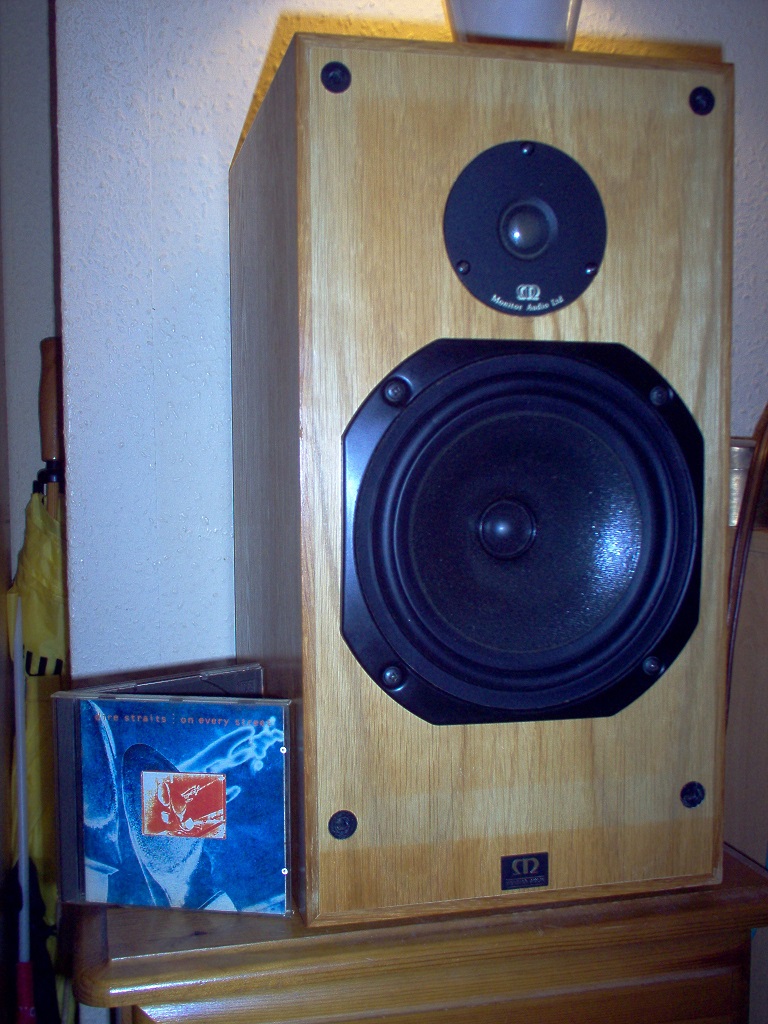
Two-ways have a certain minimalistic appeal, but I've always preferred 3 ways. 😀
The twin-mid Wharfedale E70 was always a fave. And I can see it's similarity to the Celestion 25. See, as you reduce tweeter crossover frequency, they start to sound rough. But the below is the sort of speaker that currently interests me. Twin mids reduce distortion by 6dB. That's good. Other things like impedance work well too.

Two-ways have a certain minimalistic appeal, but I've always preferred 3 ways. 😀
The twin-mid Wharfedale E70 was always a fave. And I can see it's similarity to the Celestion 25. See, as you reduce tweeter crossover frequency, they start to sound rough. But the below is the sort of speaker that currently interests me. Twin mids reduce distortion by 6dB. That's good. Other things like impedance work well too.
Attachments
With so many failed hosted images in this thread, it has become difficult to read. 😱
I had a friend round, listening to these BW3 types, and he remarked he thought they were a bit bass light:
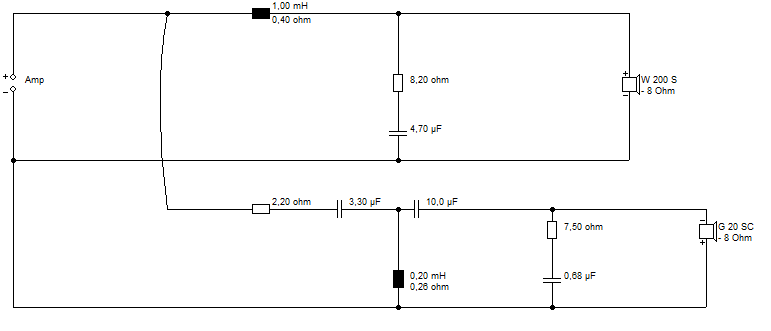
That's not hard to fix here, just a bigger bafflestep coil:
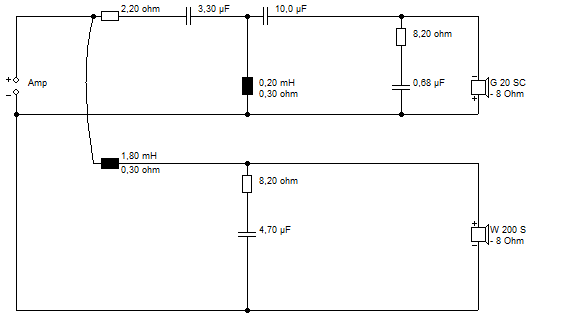
Below is the original, slightly woeful 4 element crossover. Next is 4 images of my current super-dooper 4th order LR4. This is actually fairly faultless, we are moving into very high fidelity here. I have a few future ideas to come in a subsequent post.
I had a friend round, listening to these BW3 types, and he remarked he thought they were a bit bass light:
That's not hard to fix here, just a bigger bafflestep coil:
Below is the original, slightly woeful 4 element crossover. Next is 4 images of my current super-dooper 4th order LR4. This is actually fairly faultless, we are moving into very high fidelity here. I have a few future ideas to come in a subsequent post.
Attachments
Hi Steve, moving from a 1.0mH to 1.8mH coil, I'd expect some changes are also required in the tweeter circuit to compensate for the rolloff. The Fc will change, phasing will change and tweeter will need more padding as you are subtracting another ~ 2dB BSC?
Are you planning to invest in a measurement setup? It really does help in the tuning / voicing cycle.
Are you planning to invest in a measurement setup? It really does help in the tuning / voicing cycle.
A good point about levels, Dave. And I am sure I could benefit greatly from turning my modest home into an anechoic chamber with measuring equipment.
But actually most of my interest is theoretical. AFAIK, all that increasing the bass coil to 1.8mH does is flatten a +3dB peak at crossover. Which to my ears never sounds bad at all. Because it corresponds to flat power response in the room, especially off axis. Tweeter level is a matter of taste IMO.
The reason I updated this thread is that Jonb87 has just PM'd me that he has bought some MA R300/MD and found a lot of the images had disappeared.
For the record, I think my current impedance flat circuit is a spiffing idea:
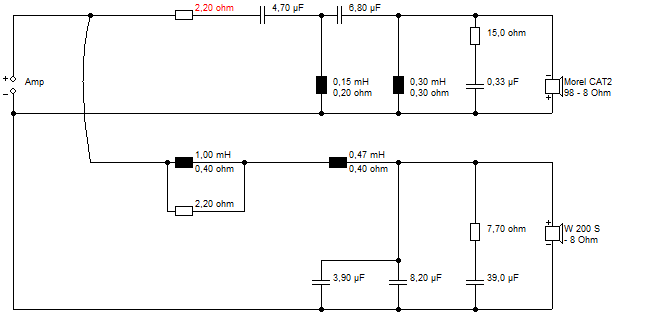

I tested it with a high inductance Visaton bass driver and a lower inductance Sony driver. For the Monitor Audio Elac unit, a Zobel of 7.5R and 15uF is probably closer to the mark.
Again for the record, a satisfactory circuit for the MA speaker with a replacement narrow dispersion cone tweeter below. That old £7 Monacor HT22/8 cheapie.
THe whole speaker crossover problem gets greatly simplified by the work of Mr. Steen Duelund. Once you settle on a bass response, the tweeter response in amplitude and phase follows, as in the last image.
But actually most of my interest is theoretical. AFAIK, all that increasing the bass coil to 1.8mH does is flatten a +3dB peak at crossover. Which to my ears never sounds bad at all. Because it corresponds to flat power response in the room, especially off axis. Tweeter level is a matter of taste IMO.
The reason I updated this thread is that Jonb87 has just PM'd me that he has bought some MA R300/MD and found a lot of the images had disappeared.
For the record, I think my current impedance flat circuit is a spiffing idea:
I tested it with a high inductance Visaton bass driver and a lower inductance Sony driver. For the Monitor Audio Elac unit, a Zobel of 7.5R and 15uF is probably closer to the mark.
Again for the record, a satisfactory circuit for the MA speaker with a replacement narrow dispersion cone tweeter below. That old £7 Monacor HT22/8 cheapie.
THe whole speaker crossover problem gets greatly simplified by the work of Mr. Steen Duelund. Once you settle on a bass response, the tweeter response in amplitude and phase follows, as in the last image.
Attachments
Last edited:
Hi, system7With so many failed hosted images in this thread, it has become difficult to read. 😱
I had a friend round, listening to these BW3 types, and he remarked he thought they were a bit bass light:

That's not hard to fix here, just a bigger bafflestep coil:

Below is the original, slightly woeful 4 element crossover. Next is 4 images of my current super-dooper 4th order LR4. This is actually fairly faultless, we are moving into very high fidelity here. I have a few future ideas to come in a subsequent post.
Do you use only air core coils? They can be very expensive, so I wonder what the consequence will be if I use coils with slightly higher or lower resistance and iron core coils? Where did you buy your parts?
Apologies for so long in replying. I have been taking a break from teh interwebs to do some more productive study on maths: Quanta Magazine
Speakers are just a two dimensional Clifford algebra. Hardly rocket science. Cauchy did all this complex variable stuff about 200 years ago. We let the bass do the bass, and the tweeter do the high frequency stuff, and hope to blend them together into an agreeable whole.
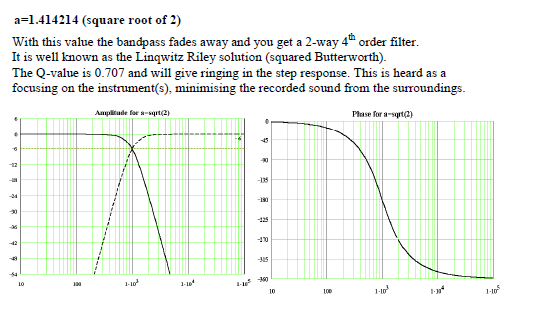
Now cast an engineering eye on this crossover:
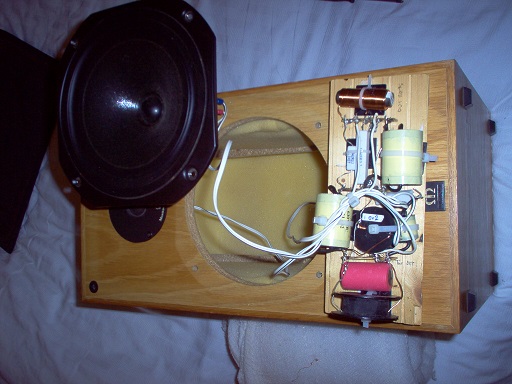
Clearly a ferrite coil on the bass there. The thing at the top. I just happen to have a few in my component box. I bought them from the splendid Wilmslow Audio in Leicester. Components and accessories
It is a scientific fact that ferrite coils are the most non-linear components in the crossover repertoire. It's called hysteresis. Possibly a baked air-coil is a better idea. Inductance is the square of the number of turns, so an air coil with low resistance (which means fat wire), is really quite affordable.But it won't be night and day over a ferrite IMO, because most speaker drivers are ferrite coils anyway. Because most speaker magnets are ferrite. AlNiCo magnets being too expensive for most folks these days.
Speakers are just a two dimensional Clifford algebra. Hardly rocket science. Cauchy did all this complex variable stuff about 200 years ago. We let the bass do the bass, and the tweeter do the high frequency stuff, and hope to blend them together into an agreeable whole.
Now cast an engineering eye on this crossover:
Clearly a ferrite coil on the bass there. The thing at the top. I just happen to have a few in my component box. I bought them from the splendid Wilmslow Audio in Leicester. Components and accessories
It is a scientific fact that ferrite coils are the most non-linear components in the crossover repertoire. It's called hysteresis. Possibly a baked air-coil is a better idea. Inductance is the square of the number of turns, so an air coil with low resistance (which means fat wire), is really quite affordable.But it won't be night and day over a ferrite IMO, because most speaker drivers are ferrite coils anyway. Because most speaker magnets are ferrite. AlNiCo magnets being too expensive for most folks these days.
Last edited:
- Home
- Loudspeakers
- Multi-Way
- Restoring Monitor Audio R300 bookshelf speakers.
